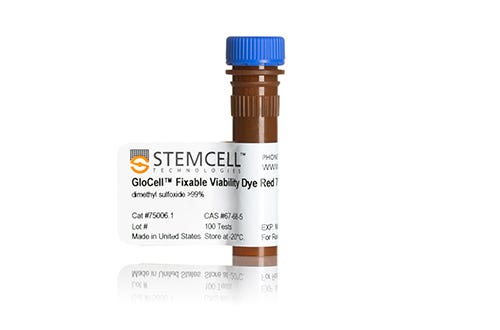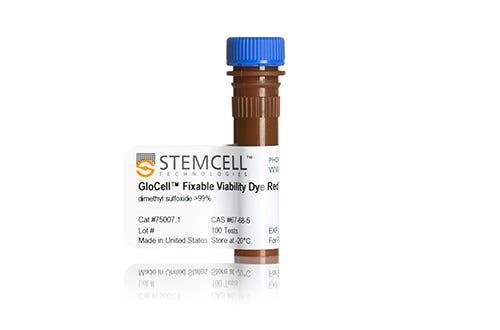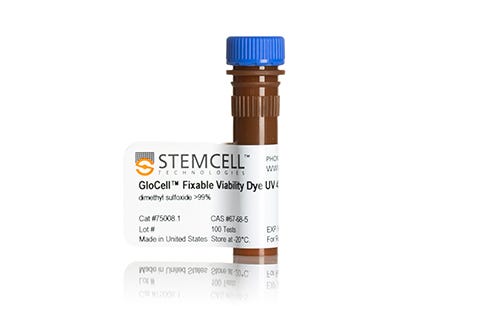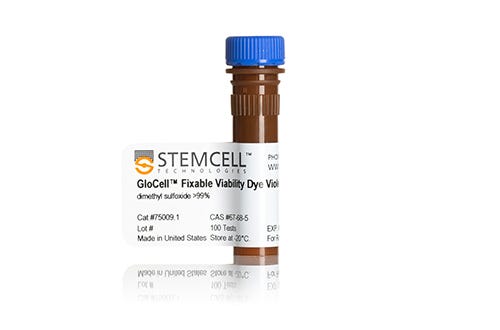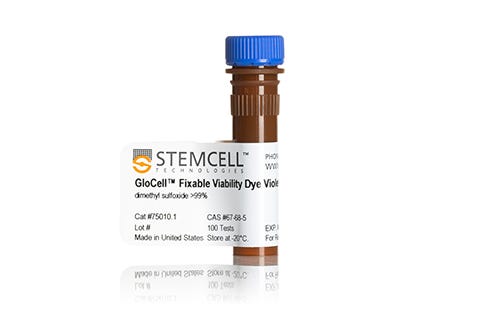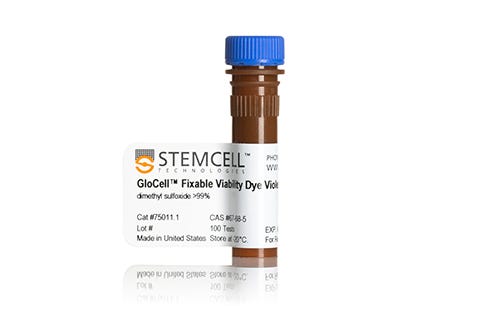GloCell™ Fixable Viability Dyes
GloCell™ Fixable Viability Dyes
Increase the Accuracy of Flow Cytometry Data by Excluding Dead Cells
GloCell™ Fixable Viability Dyes are fluorescent amine-labeling dyes for staining of live/dead mammalian cells, allowing clear exclusion of dead cells from flow cytometry data. GloCell™ dyes can also be used for visual discrimination of viable cells from dead cells during fluorescence microscopy and are compatible with intracellular antibody staining protocols.
Why Is It Important to Exclude Dead Cells in Flow Cytometry?
In the early stages of apoptosis, non-viable cells start losing their structural integrity and become increasingly permeable. Antibodies from your flow cytometry assay can cross the compromised cell membranes and bind non-specifically to the dead cells, leading to false positive results and reducing data quality. Dead cells also have greater autofluorescence than live cells, which can make it difficult to pinpoint rare cell populations or weakly positive markers. Although gating can roughly discriminate between live and dead cell populations, it is difficult to completely exclude all the dead cells based on analysis of scatter patterns alone. These issues can be mitigated by using live/dead cell staining dyes during flow cytometry.
How Do GloCell™ Dyes Work?
GloCell™ Fixable Viability Dyes are live/dead cell staining dyes that irreversibly bind to both cell surface and intracellular amine groups. With live cells, GloCell™ dyes are unable to cross the intact cell membranes and only stain the few amine groups present on the cell surface. In contrast, the compromised cell membranes of dead cells allow GloCell™ dyes access to a greater number of intracellular amine groups, resulting in higher fluorescence than from live cells. The difference in fluorescence intensity allows the user to clearly distinguish between the live and dead cell populations, ensuring reliable flow cytometry results and analysis.

Figure 1. Live/Dead Cell Staining with GloCell™ Fixable Viability Dyes
(A) In dead cells, GloCell™ dyes bind to both cell surface and intracellular amine groups. (B) With live cells, GloCell™ dyes bind only to the cell surface amine groups. (C) Difference in fluorescence intensity observed in live and dead peripheral blood mononuclear cells after staining them with GloCell™ Fixable Viability Dye Violet 510 (Catalog #75010).
Why Use Fixable Viability Dyes?
Cells that are labeled with fixable viability dyes retain the fluorescence intensity even after fixation, permeabilization, and washing. This allows easy identification and evaluation of live and dead cells following fixation of samples.

Figure 2. Preservation of Fluorescence Signals in Unfixed and Fixed Cells Stained with GloCell™ Fixable Viability Dye
A mixture of live and dead (heat-shocked at 95°C for 30 minutes) WLS-1C human induced pluripotent stem (iPS) cells were stained with GloCell™ Fixable Viability Dye Violet 450 (Catalog #75009) with or without fixation in 4% paraformaldehyde. After staining, (A) unfixed and (B) fixed cells were immediately analyzed by flow cytometry.
Why Use GloCell™ Dyes?
- VERSATILE. Available in a wide range of excitation and emission wavelengths. Can be used in fluorescence microscopy, flow cytometry, and intracellular antibody staining protocols.
- STABLE. Resistant to fixation, permeabilization, and washing.
- COMPATIBLE. Verified for use with our EasySep™ and RosetteSep™ cell isolation products.
Considerations for FACS Gating
In flow cytometry, using an optimal gating strategy is an important factor in ensuring accurate results. Read technical tips to optimize your gating strategy before sorting your samples.
